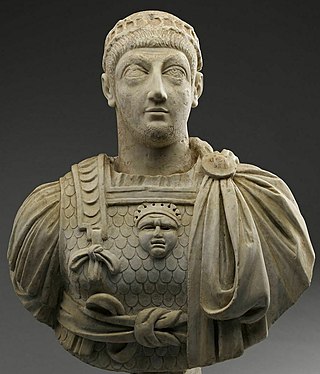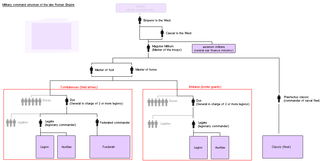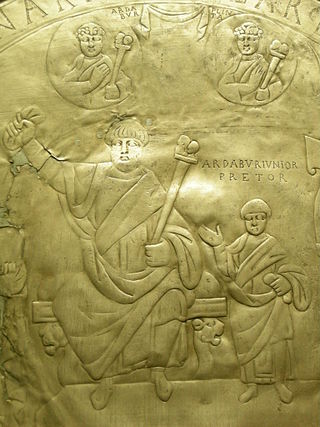The 430s decade ran from January 1, 430, to December 31, 439.
The 450s decade ran from January 1, 450, to December 31, 459.
The 440s decade ran from January 1, 440, to December 31, 449.

Year 447 (CDXLVII) was a common year starting on Wednesday of the Julian calendar. At the time, it was known as the Year of the Consulship of Calepius and Ardabur. The denomination 447 for this year has been used since the early medieval period, when the Anno Domini calendar era became the prevalent method in Europe for naming years.

Marcian was Roman emperor from 450 to 457. Very little of his life before becoming emperor is known, other than that he was a domesticus who served under the commanders Ardabur and his son Aspar for fifteen years. After the death of Emperor Theodosius II on 28 July 450, Marcian was made a candidate for the throne by Aspar, who held much influence because of his military power. After a month of negotiations Pulcheria, Theodosius' sister, agreed to marry Marcian. Zeno, a military leader whose influence was similar to Aspar's, may have been involved in these negotiations, as he was given the high-ranking court title of patrician upon Marcian's accession. Marcian was elected and inaugurated on 25 August 450.

Ricimer was a Romanized Germanic general who effectively ruled the remaining territory of the Western Roman Empire from 456 after defeating Avitus, until his death in 472, with a brief interlude in which he contested power with Anthemius. Deriving his power from his position as magister militum of the Western Empire, Ricimer exercised political control through a series of puppet emperors. Ricimer's death led to unrest across Italy and the establishment of a Germanic kingdom on the Italian Peninsula.

Valentinian III was Roman emperor from 425 to 455. Made emperor in childhood, his reign over the Roman Empire was one of the longest, but was dominated by powerful generals vying for power amid civil wars and the invasions of Late antiquity's Migration Period, including the campaigns of Attila the Hun.

Aetius was a Roman general and statesman of the closing period of the Western Roman Empire. He was a military commander and the most influential man in the Empire for two decades (433–454). He managed policy in regard to the attacks of barbarian federates settled throughout the West. Notably, he mustered a large Roman and allied (foederati) army in the Battle of the Catalaunian Plains, ending a devastating invasion of Gaul by Attila in 451, though the Hun and his subjugated allies still managed to invade Italy the following year, an incursion best remembered for the ruthless Sack of Aquileia and the intercession of Pope Leo I.

Zeno was Eastern Roman emperor from 474 to 475 and again from 476 to 491. Domestic revolts and religious dissension plagued his reign, which nevertheless succeeded to some extent in foreign issues. His reign saw the end of the Western Roman Empire following the deposition of Romulus Augustus and the death of Julius Nepos, but he was credited with contributing much to stabilising the Eastern Empire.

Procopius Anthemius was the Western Roman emperor from 467 to 472. Born in the Eastern Roman Empire, Anthemius quickly worked his way up the ranks. He married into the Theodosian dynasty through Marcia Euphemia, daughter of Eastern emperor Marcian. He soon received a significant number of promotions to various posts, and was presumed to be Marcian's planned successor. However, Marcian's sudden death in 457, together with that of Western emperor Avitus, left the imperial succession in the hands of Aspar, who instead appointed a low-ranking officer known as Leo to the Eastern throne out of fear that Anthemius would be too independent. Eventually, this same Leo would designate Anthemius as Western emperor in 467, following a two-year interregnum that started in 465.

Magister militum was a top-level military command used in the later Roman Empire, dating from the reign of Constantine the Great. The term referred to the senior military officer of the empire. In Greek sources, the term is translated either as strategos or as stratelates.
The Battle of the Utus was fought in 447 between the army of the Eastern Roman (Byzantine) Empire, and the Huns led by Attila at Utus, a river that is today the Vit in Bulgaria. It was the last of the bloody pitched battles between the Eastern Roman Empire and the Huns, as the former attempted to stave off the Hunnic invasion.
TheodoricStrabo was a Gothic chieftain who was involved in the politics of the Eastern Roman Empire during the reigns of Emperors Leo I, Zeno and Basiliscus. He was a rival for the leadership of the Ostrogoths with his kinsman Theoderic the Great, who would ultimately supplant him.

Marcia Euphemia was the wife of Anthemius, Western Roman Emperor.
Anatolius was a diplomat and general of the Eastern Roman Empire and Consul in 440. He was very influential during the reign of Theodosius II, and held command of the Empire's eastern armies for 13 years. He led negotiations with Attila the Hun on several occasions.

Flavius Plinta was a Gothic politician and general of the Eastern Roman Empire. He held the title comes, and then became consul and magister militum praesentialis.
Vitalian was a general of the Eastern Roman Empire. A native of Moesia in the northern Balkans, and probably of mixed Roman and Gothic or Scythian barbarian descent, he followed his father into the imperial army, and by 513 had become a senior commander in Thrace.
John, surnamed Mystacon, was a prominent Eastern Roman general in the wars with Sassanid Persia during the reigns of Byzantine emperors Tiberius II and Maurice.
Flavius Zeno was an influential general and politician of the Eastern Roman Empire, of Isaurian origin, who served as magister militum per Orientem, and became consul and patricius.
The history of the Huns spans the time from before their first secure recorded appearance in Europe around 370 AD to after the disintegration of their empire around 469. The Huns likely entered Western Asia shortly before 370 from Central Asia: they first conquered the Goths and the Alans, pushing a number of tribes to seek refuge within the Roman Empire. In the following years, the Huns conquered most of the Germanic and Scythian tribes outside of the borders of the Roman Empire. They also launched invasions of both the Asian provinces of Rome and the Sasanian Empire in 375. Under Uldin, the first Hunnic ruler named in contemporary sources, the Huns launched a first unsuccessful large-scale raid into the Eastern Roman Empire in Europe in 408. From the 420s, the Huns were led by the brothers Octar and Ruga, who both cooperated with and threatened the Romans. Upon Ruga's death in 435, his nephews Bleda and Attila became the new rulers of the Huns, and launched a successful raid into the Eastern Roman Empire before making peace and securing an annual tribute and trading raids under the Treaty of Margus. Attila appears to have killed his brother and became sole ruler of the Huns in 445. He would go on to rule for the next eight years, launching a devastating raid on the Eastern Roman Empire in 447, followed by an invasion of Gaul in 451. Attila is traditionally held to have been defeated in Gaul at the Battle of the Catalaunian Fields, however some scholars hold the battle to have been a draw or Hunnic victory. The following year, the Huns invaded Italy and encountered no serious resistance before turning back.









